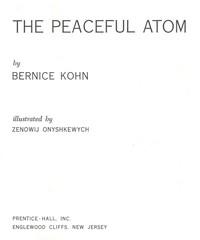|
|
Read this ebook for free! No credit card needed, absolutely nothing to pay.Words: 8996 in 5 pages
This is an ebook sharing website. You can read the uploaded ebooks for free here. No credit cards needed, nothing to pay. If you want to own a digital copy of the ebook, or want to read offline with your favorite ebook-reader, then you can choose to buy and download the ebook.

: The peaceful atom by Hunt Bernice Kohn Onyshkewych Zenowij Illustrator - Atoms; Atoms Juvenile literature; Nuclear energy Juvenile literature@FreeBooksThu 08 Jun, 2023 element never looks exactly like the atom of another element. But like the Shady Acres houses, every atom of the same element looks exactly like every other. A hydrogen atom looks like every other hydrogen atom. A carbon atom looks like every other carbon atom. But a hydrogen atom never looks like a carbon atom. Atoms are like houses in still another way, too. Even though the building materials used in two houses or two atoms are the same, the finished structure of a house or an atom depends on the way the materials are arranged. If an atom could be made large enough for you to see, you might think you were watching a satellite going around and around one or more planets. Uranium has three main isotopes. The most common kind of uranium has 92 protons, 146 neutrons, and--of course--92 electrons. The heaviest part of any atom is the nucleus. Protons and neutrons are very much heavier than electrons. And then there is lots and lots of empty space. If the nucleus of the hydrogen atom were enlarged to the size of a tennis ball, the electron would be a half mile away! A SEARCH BEGINS Now we know a lot about the structure of the atom--but we still haven't solved the mystery of the rays. So let's do that right now. We know that if an atom changes its number of protons it becomes a different kind of atom. And that is just what happens to radioactive elements. Uranium, thorium, and radium all change into lead. Other radioactive elements decay to different elements. Some radioactive elements decay very quickly--in a few seconds--but some take millions of years. As the element decays, its atoms shoot off particles. The larger the amount of the element, the more particles it shoots off. But as the element decays, there is less and less of it left. If at first it gives up 100 particles a second, it will, as its size decreases, give up only 90 particles a second. Then it will give up only 80 particles a second, and so on. When the radioactive element that started giving up 100 particles a second gets down to losing only 50 particles a second, we know that half of its radioactivity has been used up. Radium has a half-life of 1,690 years. Uranium has a half-life of 4,500 million years! Radioactivity is very interesting, but before we can understand its real importance, we must learn a little about energy. Free books android app tbrJar TBR JAR Read Free books online gutenberg More posts by @FreeBooks
: A guide to Plymouth and its history by Briggs Helen T Briggs Rose T Dreher Raymond C Illustrator - Pilgrims (New Plymouth Colony); Plymouth (Mass.) Guidebooks; Plymouth (Mass.) History@FreeBooksThu 08 Jun, 2023

: Coloured engravings of heaths; vol. 2 by Andrews Henry Cranke Active - Ericas; Ericas Pictorial works@FreeBooksThu 08 Jun, 2023
|
Terms of Use Stock Market News! © gutenberg.org.in2025 All Rights reserved.






